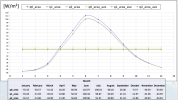mauro_morichetti
New member
Hi all,
I am working on the effect of short lived climate forcers (SLCFs) to the radiation and energy balance, on simulation with semi-hemisferic domain over the Arctic.
I have done 3 simulations last one year (2018), with RRTMG scheme for both LW and SW radiation:
1- The first one is the control simulation: is WRF with no chem and climatological profiles for ozone (o3_input=2 and aer_opt=0 --> both default);
2- The second simulation is with MOZCART chemical scheme and same as before (o3_input=2 and aer_opt=0 --> both default);
3- The last one is identical to the previuos, but with one change: I have modified the code adding a new option for o3_input=3 in which the code reads the ozone profiles calculate online (and same default value for aer_opt=0).
The code added is the following (phys/module_radiation_dirver.F):
The plot attached shows the monthly value of the area average of a energy balance at surface. As you can see the bigger gap is between values are from the first and second simulations, in particular in june.
My question is, why I have this difference between the first and second simulation? I mean, the RRTMG aerosol and ozone dependencies are both default value, so I would expected same values. How the chemistry scheme influences the radiation scheme?
Thanks in advance
Mauro
I am working on the effect of short lived climate forcers (SLCFs) to the radiation and energy balance, on simulation with semi-hemisferic domain over the Arctic.
I have done 3 simulations last one year (2018), with RRTMG scheme for both LW and SW radiation:
1- The first one is the control simulation: is WRF with no chem and climatological profiles for ozone (o3_input=2 and aer_opt=0 --> both default);
2- The second simulation is with MOZCART chemical scheme and same as before (o3_input=2 and aer_opt=0 --> both default);
3- The last one is identical to the previuos, but with one change: I have modified the code adding a new option for o3_input=3 in which the code reads the ozone profiles calculate online (and same default value for aer_opt=0).
The code added is the following (phys/module_radiation_dirver.F):
Code:
1679 ! Interpolating climatological ozone and aerosol to model time and levels
1680 ! Adapted from camrad code
1681 #if (EM_CORE==1)
1682 IF ( o3input .EQ. 2 .AND. id .EQ. 1 ) THEN
1683 #else
1684 IF ( o3input .EQ. 2 ) THEN
1685 #endif
1686 ! ! Find the current month (adapted from Cavallo)
1687 ! CALL cam_time_interp( ozmixm, pin, levsiz, date_str, &
1688 ! ids , ide , jds , jde , kds , kde , &
1689 ! ims , ime , jms , jme , kms , kme , &
1690 ! its , ite , jts , jte , kts , kte )
1691 ! this is the CAM version
1692 ! interpolate to model time-step
1693 call ozn_time_int(julday,julian,ozmixm,ozmixt,levsiz,n_ozmixm, &
1694 ids , ide , jds , jde , kds , kde , &
1695 ims , ime , jms , jme , kms , kme , &
1696 its , ite , jts , jte , kts , kte )
1697
1698 ! interpolate to model model levels
1699 call ozn_p_int(p ,pin, levsiz, ozmixt, o3rad, &
1700 ids , ide , jds , jde , kds , kde , &
1701 ims , ime , jms , jme , kms , kme , &
1702 its , ite , jts , jte , kts , kte )
1703 ENDIF
1704
1705 ! UMM --> use of ozone value calculate internally
1706 #if (WRF_CHEM == 1)
1707 IF ( o3input .EQ. 3 .AND. id .EQ. 1 ) THEN
1708 do i=its,ite
1709 do j= jts,jte
1710 do k=kts,kte
1711 o3rad(i,k,j)=chem(i,k,j,p_o3)*1.0E-6
1712 end do
1713 end do
1714 end do
1715 ENDIF
1716 #endif
1717 ! UMM --> use of ozone value calculate internallyThe plot attached shows the monthly value of the area average of a energy balance at surface. As you can see the bigger gap is between values are from the first and second simulations, in particular in june.
My question is, why I have this difference between the first and second simulation? I mean, the RRTMG aerosol and ozone dependencies are both default value, so I would expected same values. How the chemistry scheme influences the radiation scheme?
Thanks in advance
Mauro

